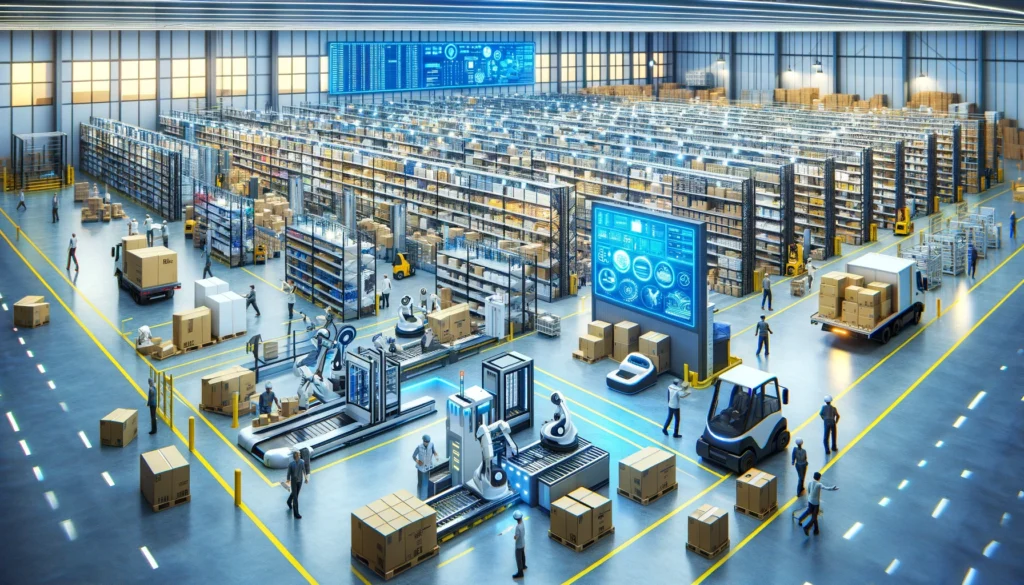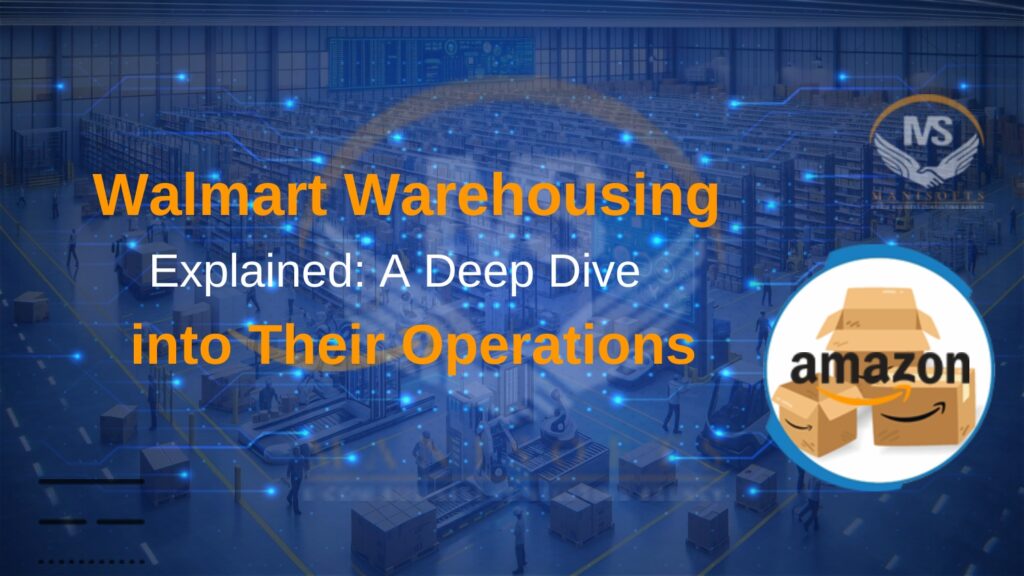This article dives deep into Walmart warehousing, exploring their distribution network, technology usage, and career opportunities. Learn how Walmart efficiently manages inventory and delivers low prices.
Introduction
Walmart’s warehousing system is a crucial part of its supply chain by which goods are distributed effectively to the store as well as consumers. Countless distribution centers across various locations strategically, and the use of high-level technology with automated way helps Walmart in sorting packing and shipping orders. Hence, the system helps Walmart to keep its prices low and productivity high. A commitment to sustainability also will continue, with Walmart pursuing initiatives that include energy-efficient practices and innovative approaches like data analytics and artificial intelligence for improving logistics. In conclusion, warehousing at Walmart is extremely important for its next-level approach towards touching customers from every corner of the world and fulfilling their needsplitting difficulty.
Walmart Warehousing
Walmart also detailed its use of automation at a recent investor event, highlighting how the system will expedite and reduce costs in inventory management as well as shelf stocking and online order processing. They were also shown around a 1.4 million-square-foot center in Brooksville, Florida that is Walmart’s initial automated distribution hub for packaged foods and other non-perishable household goods.
Walmart plans to use similar automation technology developed by Symbotic—a warehouse technology company that Walmart bought a minority stake in last year—throughout its 42 regional distribution centers. Walmart was not specific about the timeline for rolling out this, but it did say that by the end of January one-third of its stores will get distributions from such automated facilities.
The automation drive is one of the components in a wider plan to increase profits. “Over the next few years, we expect it to increase by approximately 4%,” said CEO Doug McMillon of Walmart’s revenue. That’s less growth than around the 8% seen in those pandemic years, but faster than the 3. 1% and 3.6% pace of expansion in the three years before the pandemic sushi grass quandary factor-based modelValue Line.
McMillon also said he expects profit to outpace that sales growth rate over the next five years, primarily due to the increased rollout of automation as well as scaling some higher-margin businesses like advertising and last-mile delivery and fulfillment services.
By giving us even more choices for how to buy and sending our things in the mail faster. Today, the retailer sells a much broader assortment of general merchandise, including its private-label brands across various categories like apparel, and has grown the number of third-party sellers on its marketplace.
“We’re past the point where it makes sense to continue to highlight (store) pickup, delivery and e-commerce vs. stores or more square footage at fulfillment centers,” McMillon said. “We’ve been working on fundamentals for a while now.”
In the coming years, Walmart said that it expected about two thirds of its stores to be serviced by some form of automation within three years. Moreover, close to 55% of fulfillment center volume will run through automated buildings which could cut unit costs by roughly 20%.
Technology in Walmart Warehousing
Walmart has always been the gold standard when it comes to innovation in retail logistics and supply chain management for one of the biggest retail corporations in existence. In English, “one of Walmart’s goals as the industry shifts and changes is to become more transparent with innovative solutions for [its] supply chain.” — one way it’s doing this is by using cutting-edge technology to make its warehouses smarter Integrating new technologies toward doing things smarter, using less cost and delivering better service to its customers is Walmart’s primary aim. “We take an in-depth look at some of the key technologies that are driving its warehousing success.”
1. Automated Guided Vehicles (AGVs)
Introduction of Automated Guided Vehicles (AGVs) across various warehouses (Walmart, 2018). These are the vehicles that are meant to carry out goods from corner of warehouses humans free. AGVs move along specific paths while sensing and moving with the help of sensors, lasers, cameras etc. as well And they are also used widely because of the fact, they can ship a lot of heavies by them self instead of doing it manually which may sometimes cause human damages. The AGVs while improving the speed and efficiency of these things, they also ensure that products are moved from one location to another swiftly.
2. Robotic Arms
Robotic arms: Another essential tool used in Walmart’s warehousing technology is robotic arms. All of these arms are being used to complete tasks like picking, packing and sorting. Robotic arms are embedded with powerful sensors, and an artificial intelligence (AI) that helps them pick a large number of items as they can do so with the upmost precision. They’re especially effective in industries where repetitive tasks are the norm as they can enable human workers to spend more time on high-value work.
3. Conveyor Systems
The e-commerce column: Walmart’s automated warehousing also operates on conveyor systems. By transporting products throughout the warehouse, these systems bridge areas such as Receiving, Storage and Shipping. Conveyor systems that are more advanced come complete with sensors and controls that help in the optimal flow of the goods, eliminate bottleneck processes that could delay order fulfilment. Automating the flow of merchandise enables Walmart to more efficiently and swiftly fill orders.
4. Machine Learning and AI
Here, how Walmart relies on machine learning and AI to optimize warehousing operations. These technologies can analyze massive datasets to forecast demand, optimize the inventory position and drive better decision-making. “All of this is enabled by our AI algorithms, which forecasters what products we will need and when. This way Walmart can adequately stock its warehouses before the demand pours in,” Yang said. This decreases the chances of stockouts and overstock scenarios, which means that the right products are in place at the right time.
5. Internet of Things (IoT)
The Internet of Things connects different devices and systems in Walmart’s warehouses which allows these resources to be monitored or controlled. Using IoT sensors to track goods on the move, monitor equipment performance or manage energy usage For example, temperature sensors make sure that perishable is kept under the perfect conditions. Walmart uses this technology for real-time data which helps improve efficiency, reduce waste and increases the productivity of warehousing operations.
6. Autonomous Drones

Walmart has also been known to use autonomous drones in its warehouses. These little drones can handle everything from inventory checks and barcode scanning, to movement of small items within the warehouse. Drone is highly flexible and it can go to difficult places, hence a great use of drones as well when it comes to keeping the inventory up-to-date and all the products goes in appropriate storage.
7. Blockchain Technology
Walmart is looking into the blockchain technology with an idea of bringing in more transparency and traceability to its supply chain. Blockchain will allow Walmart to make a permanent record of transactions and product movements. this is also an excellent technology to trace back the product journey, its origin, and making counterfeiting very risky. And enables faster, more secure transactions with suppliers and partners using the blockchain.
8. Warehouse Management Systems (WMS)
Walmart employs advanced Warehouse Management Systems that help in managing its warehousing activities. Software such as WMS helps businesses to manage their inventory, save on storage costs and get more efficient order fulfillment. Such systems offer Walmart real-time visibility into many of its warehouse tasks, so the company can make smart choices on the fly and react to changes in demand quickly. Meanwhile, WMS can also be integrated with several other technologies to develop a high-performing warehousing system.
Workforce and Training in Walmart Warehousing
The evolution of Walmart’s newest warehousing operations, along with new technology deployments soon to be in place at this Arkansas center, is further illustration how much its workforce role as has changed.” In addition, the adoption of automation and digital based tools requires a highly trained workforce that will be able to operate and sustain complex systems. Walmart puts a lot of investment into segmenting its workforce and keeping operations running smoothly as the company speaks loudly about how much it invests in training everyone on all aspects from top to bottom. I am going to breakdown how Walmart is making it work with workforce and training for its highly sophisticated warehousing operations.
Adapting to Technological Changes
Automated systems, such as Automated Guided Vehicles, robotic arms have brought revolution in the traditional labor practices and roles of employees at Walmart warehouses. (Walmart learns to live with labor pains., 2014) Workers who were on the production paths now just have to oversee and manage what is being produced. After all, this transformation is accompanied by the rise of a wholly different range of capabilities — from technical knowledge to diagnostics and maintenance skills for increasingly sophisticated machinery.
Comprehensive Training Programs
To remain competitive and meet the needs of its workforce in an ever-changing, technology-driven environment, Walmart understands that upskilling is a strategic imperative,” The company provides its employee developing training programs which help them in nurturing their abilities. In the end, a range of study programs that span major areas of interest including:
- Technical Training: Get down and dirty with how to operate and maintain the automated systems we have onsite from AGVs, conveyor belts, robotic arms etc. through on-the-job training Training is given to the workers so that they can efficiently handle these technologies and solve any query if generated.
- Safety Training: Safety is the #1 priority in Walmart warehouses. Attention is devoted to the effective and safe functioning of all automated features and property entry, as well as manual tasks. how to safely work with machines and safety during emergency situations.
- Digital Literacy: Walmart gives exposure to its employees regarding the use of digital tools as they are expanding their reach on various software applications like Warehouse Management Systems (WMS) into the warehousing environment. Employees are trained on how to use these systems for tracking inventory, executing orders and structuring warehouse processes.
- Soft Skills Development:While training its employees Walmart focus not only on the technical aspects but soft aspects such as problem-solving, working in a team and communication. Trying to re-build the will and skill in critical areas, without which employees won’t be able to work together well and adopt fresh ways of working.
Career Advancement Opportunities
Walmart’s work to help them build the skills opens up dozens of different possibilities, as this story shows. But it doesn’t end there either. 9 – Offering Continued Education and Opportunities For Job Growth Walmart also allows its employees to undergo further education and certifications that would take them ahead in their career with the help of Walmart Academy. What’s more, this not only proves to be profitable for the employees but also helps Walmart assure that it has a good set of proficient workforce who are ready to take on future challenges.
Retraining and Redeployment
As automation continues to be popular, it’s getting worrying that a certain kind of traditional job roles may go out of existence. To tackle this problem, Walmart has introduced retraining initiatives, that assist employees in moving to new job roles. For example, a laborer tasked with doing the actual sorting by hand in the past could be retrained to work as an operator of robotic sorting systems. This way, people are not losing their jobs and can still go on to be vital assets of your company.
Embracing a Culture of Continuous Improvement
Walmart promotes an environment of continuous growth and sustainability. So if you want to bring change or be innovative, then not to worry, employees are given enough chances and pushed to keep track of the happening technological advancement in and around their domain. The company provides access to online learning platforms, workshops and seminars for the growth of employees.
Supportive Work Environment
Building a supportive workspace is also essential to make sure that new technologies launch well. A great example of this is Walmart and their culture of inclusivity and collaboration, where employees are valued as equals. These feedback mechanisms are used to address their concerns and suggestions – providing a continuous motivation potential for the workforce.
Walmart Warehousing and Supplier Relationships
The world’s largest retailer, Walmart, developed a complex and efficient supply chain that is key to its success (Maughan). [opening quote] The resulting network is critically dependent on the company’s warehousing operations, which are deeply integrated with supplier relationships Walmart cultivates strong supplier relationships and fine-tune warehouse systems to guarantee that goods travel from the manufacturer to the buyer with minimal disruptions. Now, let’s deep dive to understand Walmart’s operational excellence using its warehousing and supplier relationship.
Strategic Supplier Partnerships
The Company’s supplier relationship is based on collaboration and mutuality WMT: Walmart overseas its relationship with the suppliers through to ensure it benefits both parties. e) Close association with suppliers: The Company closely work its relation to the supplier to get assure of them meeting stringent quality, cost and delivery screening at their own ends. Creating long-term relationships also allows Walmart to obtain lower prices with their suppliers and assure itself a constant flow of products, key points for the company’s strategy based on a low-cost leadership.
Efficient Inventory Management
Walmart’s warehousing system is based on efficient inventory management. Advanced inventory management systems allowing real-time view of stock levels across the company’s distribution centres The system allows Walmart to improve the inventory situation, reducing stockouts and preventing overstock. This also places suppliers in a seemingly advantageous position, with the prospect of receiving more regular and consistent order quantities.
Collaborative Planning and Forecasting
“. We partner with our suppliers on demand forecasting and inventory ordering.” With initiatives like the CPFR (Collaborative Planning, Forecasting and Replenishment), Walmart collaborates with its suppliers to share data and insights into how best they can help each other anticipate this demand. “These types of collaborative efforts between the supplier and manufacturer help both parties align existence production, as well as distribution plans and minimize disruptions to ensuring that we have our products available when and where they are needed,” she says.
Advanced Technology Integration
Walmart’s warehousing operation will depend on a complex set of advanced technologies, which are linked to its supplier systems and support improved efficiency and transparency. Electronic Data Interchange (EDI) technology enables Walmart to communicate in a near-perfect manner with their suppliers and exchange orders, invoices as well as other shipment informatics at the same time. The integration helps all parties to minimize mishaps and pushes supply chain workflow into a more seamless process.
Supplier Quality Assurance
Walmart prioritizes having high quality products The company has strong quality assurance programs to check that its suppliers fit into it. It could be things related to audits or inspection by Walmart which take place time and again each year for all suppliers. At the same time, suppliers are also motivated to make an attempt towards continuous improvement in modifying their processes leading to better deliverance.
Sustainable Sourcing and Ethical Practices
If one needs any more proof that Walmart is serious about sustainability and ethical sourcing, the opposite should be expected of its key suppliers. The company has ambitious goals to reduce its environmental impact, and actively encourages sustainable practices throughout the supply chain. To which all the suppliers are expected to take an account on Walmart supplier code of conduct, labor practices, environmental stewardship and moral business etc. Walmart hopes to achieve a more sustainable and responsible supply chain by having its suppliers align with such views.
Efficient Warehousing and Distribution
Walmart chain of distribution centers are fine located to market the flow of goods from supplier to store and clients. The distribution centers leverage technology including automated sorting systems and robotics among others to operate efficiently. This will reduce lead times and provides a degree of certainty in terms of order fulfilment accuracy through the streamlining of warehousing. This lower cost is an advantage which can be passed to our customers in the form of fewer price.HttpServletResponse
Continuous Improvement and Innovation
Walmart is driven to work with suppliers for maximum improvement and innovation. The company also inspires suppliers to embrace new technologies and practices in efficiency and quality. Walmart likewise puts resources into examination and advancement to create innovative answers for its inventory network. This culture of innovation ensures that Walmart and its suppliers are on the leading edge of trends as they develop, ultimately allowing them to be more responsive to consumer needs — whichever way those may shift.
FAQ’s
A portion our distribution network is the world’s largest, servicing stores and clubs, as well as direct delivery to customers Walmart’s transportation fleet consists of 9,000 tractors, 80,000 trailers and over 11,000 drivers.
In 2021, meanwhile, Walmart confirmed it had invested $14 billion into supply chain automation. This investment encompasses investments in automated warehouse management and control systems (which refer not only to related software solutions but also to complementary hardware components, such as the automated “picking”, “sorting” or “putting-away” products etc.).
Big box retailers are business that have become very successful and have ended up monopolizing and taking over the niches they once operated in. Such big-box operators include Walmart, IKEA, Tesco or Home Depot. The original type of big-box retailers are the warehouse clubs like Costco for example or BJ’s. These stores offer customers many advantages that include low prices, a wide selection of goods, and convenience
Although the majority of its suppliers were allocated in the USA, Walmart acts a global supply chain because even its suppliers is in UK, Canada, China Mexico Taiwan Hong Kong France and other else.
The three primary strategies which are practiced by Walmart to develop their supply chain includes distribution strategy, vendor relationships and technology. All these elements are interrelated and coordinated to form one integrated supply chain, dedicated to the swift and efficient delivery of products to Walmart’s stores.
Conclusion
As you can understand by reading the above details, these initiatives exhibit indicate Walmart’s dedication towards increased efficiency and endless possibilities to innovate while ensuring excellence in supply chain operations. Combining the use of sophisticated technology, strong supplier partnerships, and extensive workforce training has enabled Walmart to build a powerful warehousing system to support its massive retail operations. It doesn’t just support the outbound operations, and the accurate and on-time delivery of the products but prevents Walmart from losing its position in Global Retail Space. Throughout Walmart’s continued transformation and response to new challenges and opportunities, its warehousing operations will be the bedrock on which it continues successfully pursuing its vision of bringing quality goods at low prices to people around the globe.




